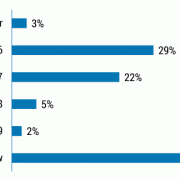DA & DT VOL. 15, NO. 17

The Internet of Things (IoT) continues to generate a huge amount of interest, touting how embedded sensors combined with mobile, cloud, and analytics technologies will lead to a multitude of connected devices and services (all generating a deluge of data), which will open up vast opportunities in the consumer, business, technology, and industrial markets.
Yet just what is the status of IoT efforts within organizations? In addition, how do companies view the IoT, and connected products in general, in terms of importance? Moreover, what are the main factors influencing organizations to develop connected products and services, and what are their plans for developing such applications in the near future? Just as important, what are the issues and roadblocks organizations perceive as standing in their way?
To gain insight into these and other questions, Cutter Consortium conducted a survey from June through October 2015 asking 80 organizations worldwide about their thoughts and plans for the IoT. This Executive Update — Part I in a series — examines survey findings pertaining to the following:
- How organizations view the IoT in terms of importance
- How organizations perceive IoT hype and the IoT’s potential as an industry disrupter
- Current status and plans for corporate IoT budgets
How Important Is the IoT?
First up, the survey sought to find out the degree of importance organizations attach to the IoT as well as connected products in general. As Figure 1 illustrates, just under half (46%) of surveyed organizations currently consider the IoT as either “very important” or “important” and are either actively developing connected products and services or are undertaking research and/or making plans to develop such offerings. Another 37% see the IoT as “somewhat important” and believe the IoT holds considerable promise; however, these organizations have yet to develop any concrete plans for building connected products and services. Altogether, 83% of responding organizations currently attach some degree of importance to the IoT. Organizations that do not view the IoT as important are clearly in the minority.
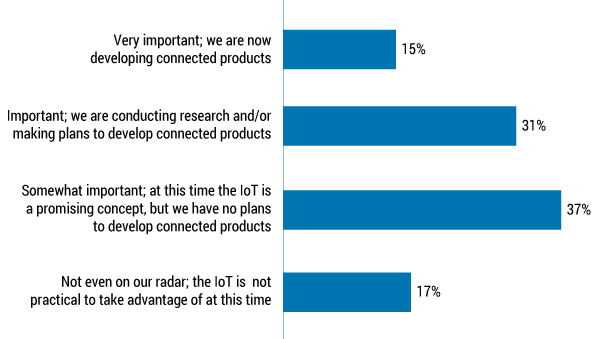
and connected products, in general, in terms of importance?
These findings indicate that current interest in the IoT and the promises it holds is considerable. That said, the findings also show that actual development of connected products and services is currently limited (i.e., well under 20% of surveyed organizations are actively developing for the IoT). Moreover, although very interested in what the IoT may have to offer, 17% of respondents feel that it is not very practical to take advantage of connected products and services at this time.
SURVEY METHODS
The survey findings presented in this Update represent the answers of 80 organizations worldwide of various sizes. In addition, I also draw from some communications I had with respondents who contacted me with more information and insight.
Fifty percent of responding organizations are headquartered in North America, 19% in Asia/Australia/Pacific, 11% in India, 10% in Europe, 8% in South America, with the remainder in Africa and the Middle East. Responding organizations’ annual revenues also vary, with 19% having annual revenues over US $10 billion, 20% having annual revenues between $1 billion and $10 billion, 14% having annual revenues between $100 million and $1 billion, 21% having annual revenues between $10 million and $100 million, 13% having annual revenues between $1 million and $10 million, and the remaining 14% having annual revenues under $1 million.
This information reveals that our findings are based on a sample of organizations located in various geographic regions, consisting of a broad range of small, medium-sized, and large companies with yearly revenues ranging from less than $1 million to more than $10 billion.
Gauging the Hype and the IoT as an Industry Disrupter
Survey findings reveal that although the hype surrounding the IoT may be considerable, organizations do view the technology as having the potential to be a game changer. As Figure 2 shows, nearly half of the respondents believe that the IoT has the potential to live up to all its hype. In addition, and perhaps more important, when asked if the IoT could dramatically disrupt their industry or line of business (LOB), nearly a quarter said yes (see Figure 3).
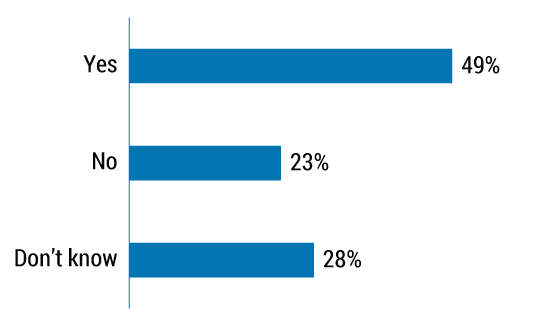
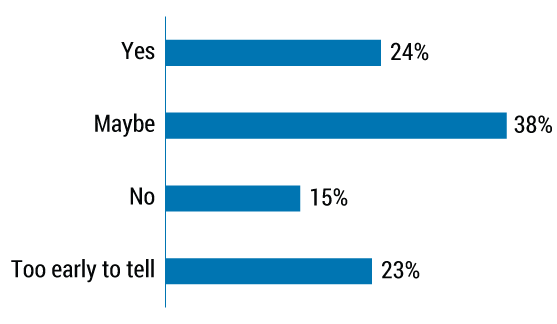
In general, these findings strongly suggest that organizations do not take the IoT lightly. On the contrary, they attach significant interest as to how it could seriously influence how they operate or do business in their particular industries.
Budgeting Status for IoT Initiatives
Probably no better measure exists for gauging the extent to which a technology or practice impacts the corporate world than the existence of budgets. As Figure 4 illustrates, just 22% of respondents report that their organizations have actually developed budgets to support their IoT initiatives. On the other hand, more than half indicate that their organizations have not yet developed an IoT budget, while another 27% are unsure.
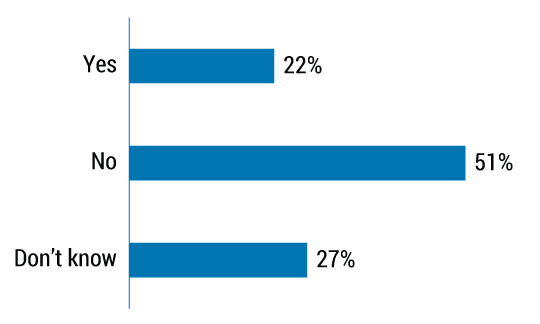
When asked when their organizations expect to develop a budget to support their IoT efforts, respondents overwhelmingly point to 2016 and 2017 (see Figure 5). That said, more than a third are not able to pinpoint a time frame. The bottom line is that 2016 and 2017 appear to be the years when the majority (51%) of surveyed organizations expect to implement their IoT budgets.
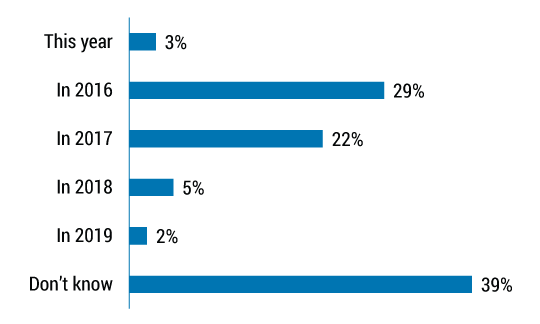
Conclusion
Cutter’s latest survey on the IoT points to several crucial findings pertaining to how organizations currently perceive the IoT as well as connected products and services in general:
- Organizations are excited but hesitant about the IoT. The respondents overwhelmingly view the IoT as very promising. That said, current development of connected products and services is limited, with just 15% of organizations actually doing so. Moreover, although many organizations (37%) are very interested in the potential of the IoT, they believe it’s simply not practical to take advantage of connected products and services at this time.
The current hesitancy expressed by organizations as to how they should respond to the IoT is understandable. The IoT encompasses new concepts, technologies, and practices that many mainstream organizations (i.e., those outside the engineering and science fields) do not have much experience with; for example, designing, implementing, and managing connected applications, sensor data analysis, machine learning, and so forth. Consequently, many organizations simply are unsure at this time how to go about applying IoT technologies and practices in a way that will benefit their business. Another major concern hindering corporate IoT initiatives is the lack of industry standards and frameworks for implementing connected products and services as well as issues surrounding security and ensuring customer privacy. (We consider survey findings addressing these and other issues in Part II of this series.)
- The IoT will live up to the hype. Nearly half of surveyed organizations feel the IoT will eventually live up to all its hype. Moreover, nearly a quarter believe the IoT has the potential to dramatically disrupt its industry or LOB.
- Budgeting for IoT initiatives is currently limited. Only 22% of respondents report that their organizations have implemented budgets to support their IoT initiatives. The fact that less than a quarter of organizations have developed IoT budgets is quite telling and further underscores the uncertainty and hesitation surrounding the IoT at this time.
- Organizations look to get serious about their IoT efforts. With 51% of respondents indicating that they plan to implement IoT budgets in 2016 and 2017, next year looks to be a breakout start for IoT initiatives. This finding is important, as it signals that organizations will soon start shifting their IoT plans into gear. Consequently, those organizations that have not done so already should now begin to formulate ideas and plans as to how they can take advantage of connected solutions in order to optimize existing products and services. Furthermore, organizations should also examine how the IoT can pave the way for new lines of connected products and even entirely new business models — both of which could potentially disrupt their industries.
Part II of this Update series focuses on the perceived benefits and trends influencing organizations to develop IoT applications and services as well as the issues and roadblocks hindering their efforts.


